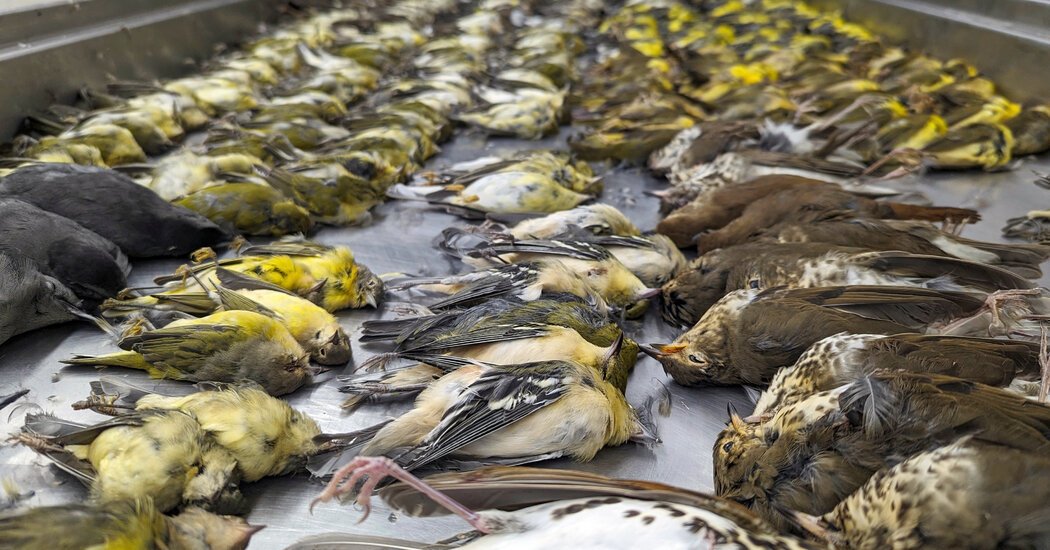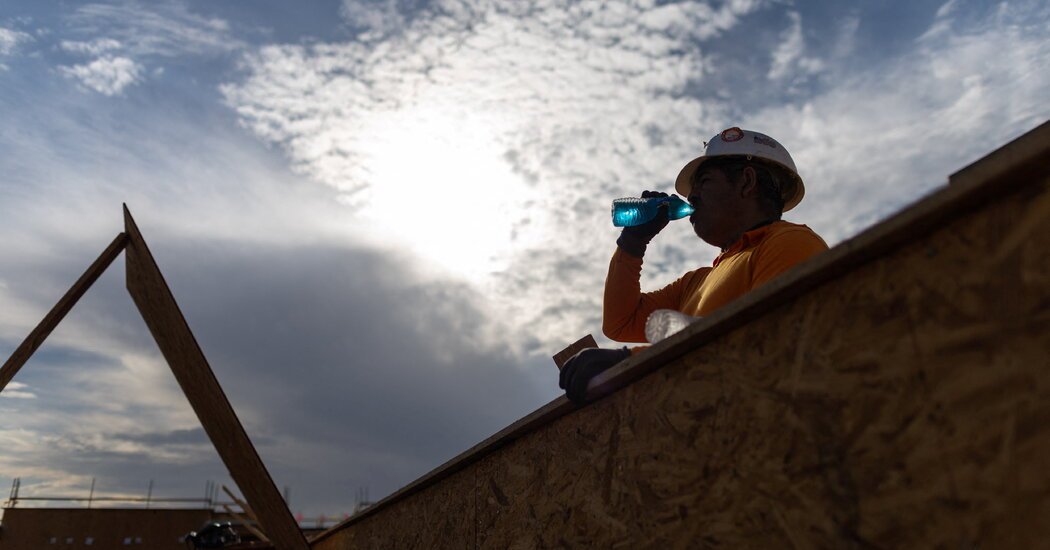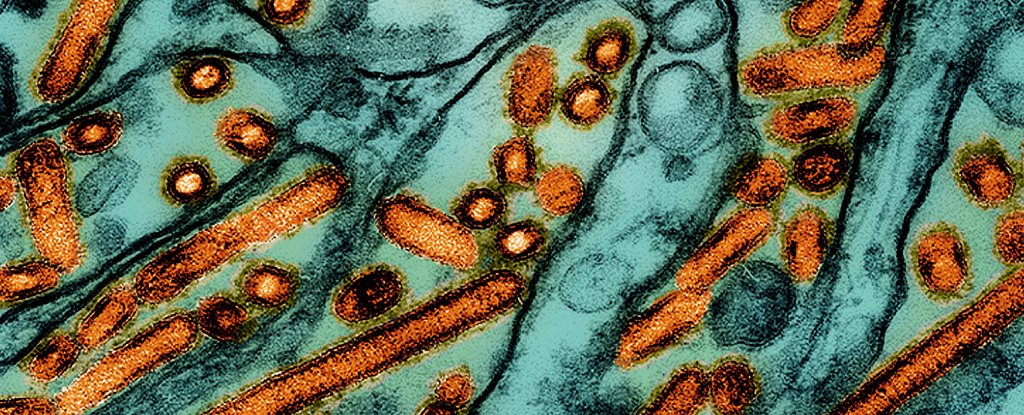One night in October, an enormous swirl of birds flew over Chicago, astounding those who had their binoculars trained on the flashes of yellow, white and brown speckling the sky above. It seemed like an incredible moment for birders, but the next day ended with nearly a thousand dead birds outside one building along Lake Michigan and even more scattered across the city’s streets.
Migration experts said that the unusual mass deaths were the product of a number of common occurrences happening all at once. One factor, they said, was easily preventable: the number of buildings that had their lights on, which disoriented birds that were migrating overnight on Oct. 4.
Since October, there have been significant changes at the building where the highest concentration of birds died, McCormick Place Lakeside Center, but advocates for bird safety are seeking measures that protect birds across the city. These measures could include treating windows with film that is more visible to birds, using shutters or drapes to block windows and turning off decorative lighting at night during migration seasons.
Judy Pollock, president of the Chicago Bird Alliance, said that the changes at McCormick Place were excellent. “But there’s a lot of other buildings that need to do something about their windows,” she sThe Chicago Bird Collision Monitors, a volunteer group that recovers dead birds and helps those that are injured, found 1,600 dead or injured birds in a downtown area smaller than two square miles on Oct. 5, said the group’s director, Annette Prince. Ms. Prince said thousands of additional birds could have died or been hurt in the city, because the group does not reach every area and birds may have struck buildings after the volunteers left.

Chicago has some of the highest migration traffic in the country because of its location in the center of the United States. It was named, along with Houston and Dallas, as one of the most dangerous cities for migrating birds in an April 2019 study published in the journal Frontiers in Ecology and the Environment.
For years, bird safety advocates have tried to get Chicago to pass an ordinance, similar to one in New York City, that would require new buildings to be safe for birds. The ultimate goal is to make bird safety a requirement for all buildings, new and old.
In April, the Chicago Department of Planning and Development unveiled a draft of its sustainable development policy that included updated bird protection standards, but those would be voluntary and not mandatory. (The policy is expected to be implemented in the coming months.)
“We feel that Chicago poses such a great threat to birds,” Ms. Prince said. “And yet they continue to stall on taking action.”
The voluntary standards include protecting areas of a building that are especially susceptible to bird strikes, such as glass railings, decorative panels and awnings, with materials, like decals or wood, that birds can see better than highly reflective or transparent materials.
The standards also encourage buildings to have a minimum of 20 feet between glass walls and exterior pools or fountains and to be able to control decorative lighting so it can be turned off between 11 p.m. and daylight during migration seasons. Tenants of buildings on higher floors should also be encouraged to turn out lights or draw blinds after 11 p.m., the guidance said.
Peter Strazzabosco, the deputy commissioner of Chicago’s Department of Planning and Development, said in an email that mandatory standards would require City Council legislation.
The Sustainable Development Policy gives points to new developments based on what sustainability standards they use to reach a required threshold. The 2024 update places higher value on bird protection than before. “The Planning Department recognizes that Chicago’s location along a major flyway poses a hazard for migrating birds,” Mr. Strazzabosco said. The department expects that increasing the point value of bird protections would encourage more new developments to adopt them, he said. About 10 percent of projects have chosen bird protections in the past, he said.
During this year’s spring migration, more than 54.7 million birds flew over Chicago, and there were no mass death events like the one last fall.
In the days before what some birders called the Chicago megaflight, the winds had been bad for migration, so large numbers of birds waited outside the city for conditions to improve, said Benjamin Van Doren, an assistant professor at the University of Illinois at Urbana-Champaign who studies migratory animals. He was involved with the 2019 study about dangerous cities for migration.
Once the weather became safe to fly in outside the city, a huge concentration of birds headed south and encountered intense thunderstorms. As the birds flew lower to avoid the storm and find land, they faced hazards including Lake Michigan and the city’s bright buildings.
Another hazard: McCormick Place Lakeside Center, an event center along the shore of Lake Michigan that is covered in about two football fields’ worth of glass. The building was lit for an event when the collisions happened, and nearly 1,000 birds were found dead outside.
David Willard, a retired collection manager of the bird collection at the Field Museum in Chicago, has been monitoring bird strikes at McCormick Place since 1978, making the building an unusually fertile resource for studying risks to birds.
During migration seasons, Dr. Willard or another museum representative will walk the perimeter of the building around dawn searching for birds that have struck the building. The Field Museum has collected more than 40,000 dead birds over the years (and helped between 4,000 and 4,500 stunned birds).
Dr. Willard said that in more than four decades, his team had never found as many birds as it did that day in October. Birds were still hitting the building well after dawn, he said. “It was almost like you could have put a brick wall in front of them, and they still would have hit it,” he said.
The 977 birds killed were mostly warblers, Dr. Willard said. The most common type found was the palm warbler, of which there were more than 300, followed by the yellow-rumped warbler. Among the other types of birds were also soras, indigo buntings and wood thrushes. Another 100 birds were found stunned and were later released away from the building.
After the bird deaths, representatives from McCormick Place joined Dr. Willard on his perimeter walks. The building’s owners have also consulted bird experts, including those at the U.S. Fish and Wildlife Service.
Larita Clark, the chief executive of the Metropolitan Pier and Exposition Authority, the municipal corporation that owns McCormick Place, said that the authority was planning to install window film that creates a pattern that birds can see. The film will cost about $1.2 million, Ms. Clark said, and the authority is aiming to have it installed by the fall migration season. The group also considered buying motorized drapes and blinds but decided that it was too costly.
Ms. Clark said that the building also participates in the Lights Out program, a campaign that calls on buildings across the country to turn off or dim lights at night during migration seasons. At McCormick Place, drapes are closed for the entire day on windows that have them, and when an event is over and people have left, the lights are dimmed to 25 percent.
Dr. Van Doren said policies that reduce or eliminate light from buildings were a simple way to reduce bird deaths.
“It’s a really big issue, but it’s also an issue that with concerted effort, we can easily tackle and have immediate impact,” he said.










